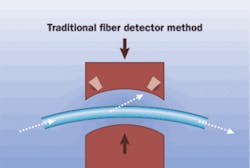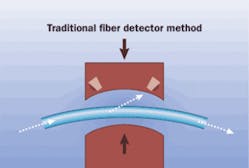New fiber-detection technology lets you safely identify a fiber with certainty, with no danger to the integrity of the transmission.
When network service providers invest in an outside-plant (OSP) infrastructure, they want to ensure that they obtain the utmost value from it. Therefore, once the network is up and running, one of the most crucial parts of its operation and maintenance is a good fiber-management system that lets technicians readily access the network to perform common operations, such as adding new subscribers, modifying services, and troubleshooting.
Uh-oh...
In the day-to-day maintenance of these networks, technicians must conduct a number of optical tests requiring that fiber be disconnected so that a test signal can be sent through the system. One of the inherent difficulties of these tests is that many of them are conducted at two different ends of the network, making it quite difficult to identify which-fiber-is-which. In fact, it is quite common for technicians to disconnect the wrong fiber by mistake or to damage nearby connections when attempting to troubleshoot a link.
Human error is indeed a major cause for concern-and not just on the technician’s end. On the administrative end, it is becoming increasingly clear that fiber-identification records are poorly kept (if at all), so when technicians go out in the field to test a connection, there are no plans or charts to help them determine which patch cord to pull, thus causing outages and inconveniencing numerous customers.
Such occurrences and their consequences are even more serious when working on a passive optical network (no backup) or on a small and contained high-fiber-count termination point, where it becomes nearly impossible to find and reach a specific fiber.
Considering these unchangeable, real-world circumstances, it is clear that the risks related to human error could be greatly reduced if the need to access the actual signal was eliminated-or, at least kept to a minimum. Fortunately, new technology is addressing these challenges and, by doing so, is letting service providers increase profitability and reduce maintenance costs while enhancing customer service.
Thumbs up, in most cases
Live fiber detectors (LFDs) are common tools in the outside-plant world and have many applications:




